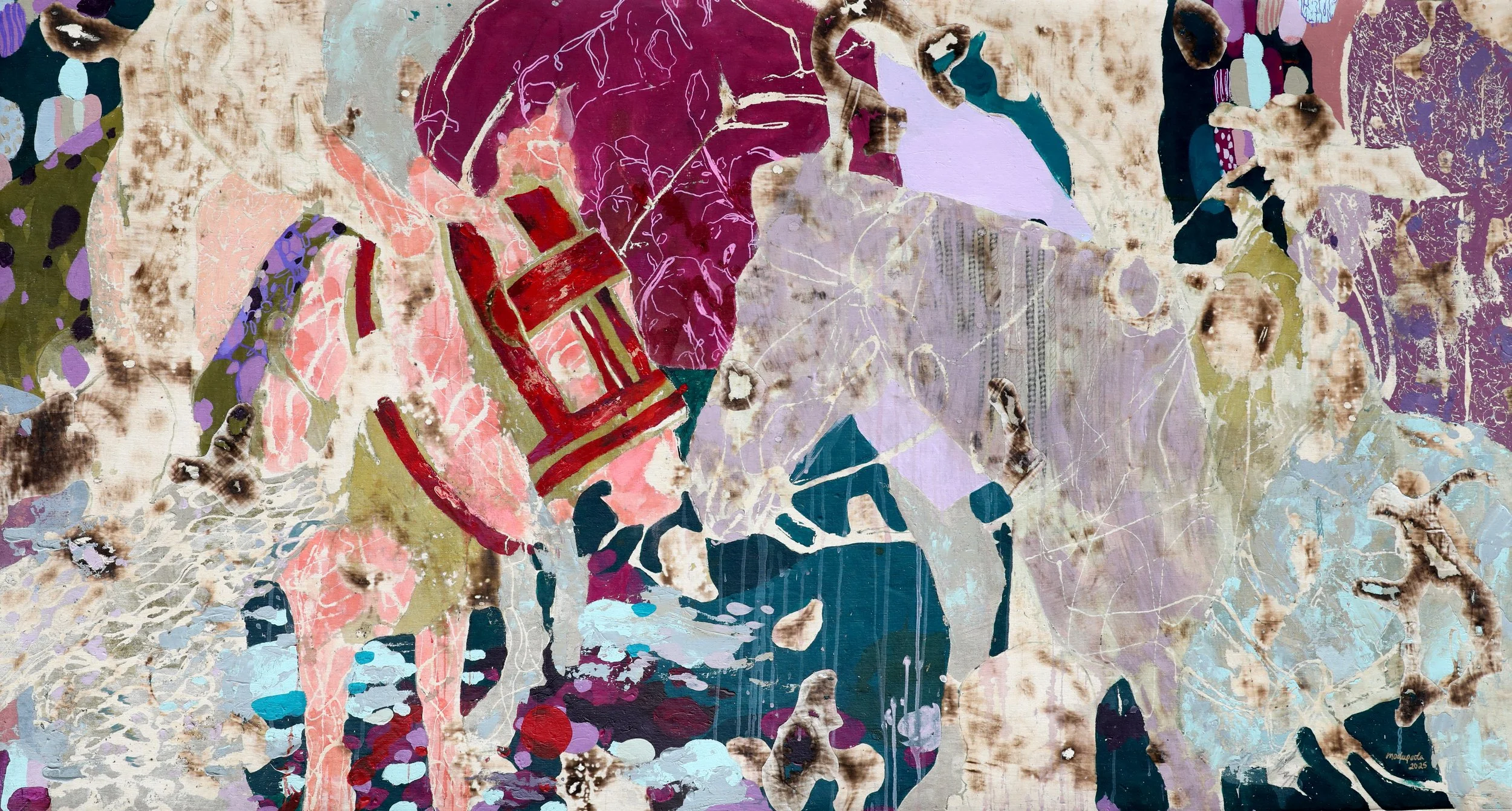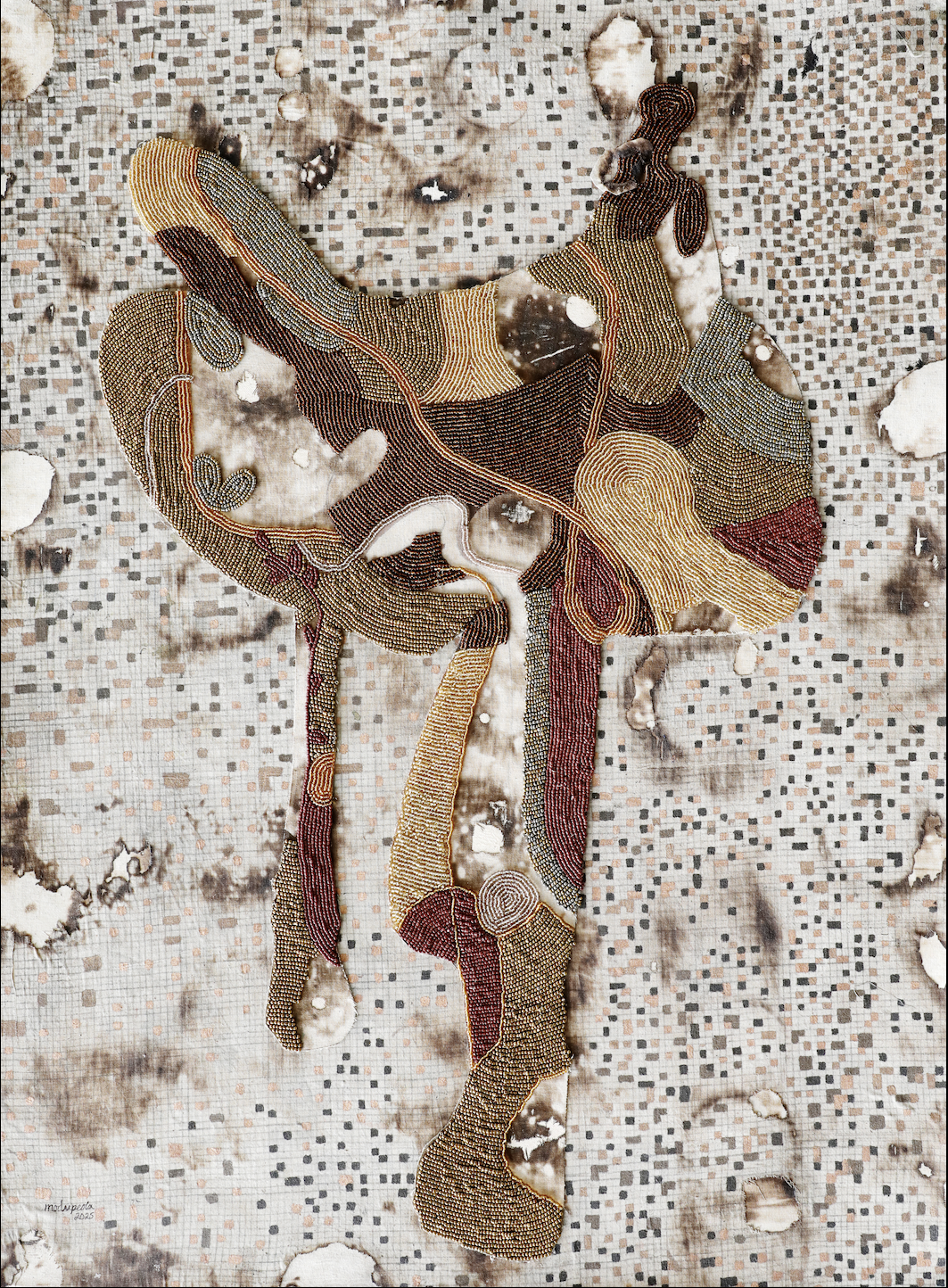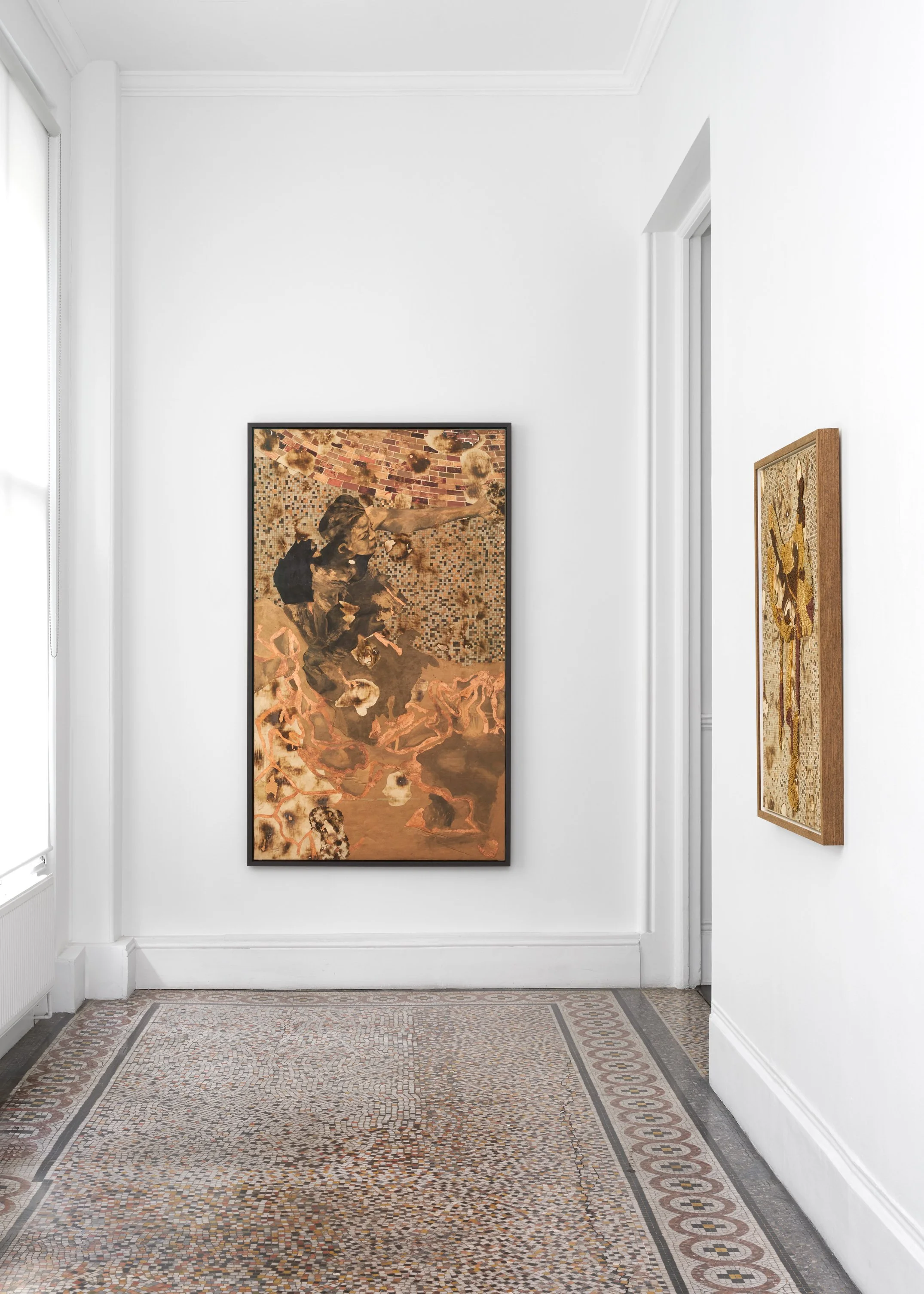Gallery 1957 presents “Of Movement, Materials, and Methods”
A Solo Exhibition by Modupeola Fadugba in London
May 22nd - June 29th, 2025
Omi adágun a bèéri lójú. Èyi tó ń lo tó ń bò ló ń mó.
Stagnant water is replete with dirt; it is the flowing stream that remains clean.
For the last ten years, I have painted swimmers—figurative and abstract bodies suspended in gold and black waters across Dakar, Lagos, Harlem, and Ibadan. The pool was my portal: a site of both resistance and release. But water, like meaning, must move. And so must I.
The Yoruba adage speaks of the cleansing power of movement. And I, too, am moving, toward land, toward tradition, toward community. My palette has changed from restrained monochromes to bold chromatics, and so has my gaze. This exhibition marks a turning, a shift from fluid surfaces to solid ground, from floating figures to the choreography of horses and people, and from quiet reflection to vibrant pageantry. It is, in a sense, a continuation of the inquiry at the heart of my 2021 solo exhibition, Why Nations Win, which explored the role of artists in envisioning and documenting Nigeria’s evolving identity. That question still underpins my practice, now cast in a different rhythm.
This is a beginning—a flowing stream, not yet the full river. It is an introduction to the Ojude Oba Festival seen through the lens of gesture and garment. Held annually in Ijebu-Ode, Ogun State, Nigeria, the festival brings communities and families together to pay homage to the royal majesty, the Awujale of Ijebu land. It takes place a few days after Eid al-Kabir (Ileya) and features parades, traditional music, and elaborate displays of horsemanship. This exploration begins with the agbada—that majestic Yoruba robe, as both symbol and entry point. In its folds, stories gather; in its shimmer, we see not only ceremony but continuity.
Over the past year, I’ve been listening. To the festival. To the people of Ijebu-Ode, whose spirit and unparalleled hospitality have shaped every thread of this work. I’ve spoken with families who prepare for Ojude Oba year after year, not for spectacle, but as an offering. It is more than a cultural event, it is a living manuscript authored by many hands. And to do it justice, I know I must return when the festival takes place later this year—to immerse myself fully in its rhythm. For now, this is a prelude. A gesture of reverence, stitched bead by bead.
My relationship with beads stretches far. As a teenager, I shadowed traditional Maasai beaders in Arusha, Tanzania, watching how they shaped purpose and pattern with their hands. Long before I spoke the language of paint, I spoke in beads: As a six-year-old growing up in Delaware, I repurposed broken jewellery from my mother’s collection and tried to sell them to neighbours. That instinct to gather, to mend, to make something beautiful from fragments—it has stayed with me.
I carry a reverence for the properties of things. How surfaces bond. How pigments flow. How time alters texture. In my undergraduate studies as a chemical engineer, we analysed materials and methods to understand transformation. In the studio, as an artist, I continue that investigation. Graphite pencil, seed beads, burned canvas, embroidery thread, gold and bronze leaf, archival glue—each holds its chemistry, its temperament. I listen to what they ask of me and let methods emerge from the material.
People, too, are material in my practice—living resources whose knowledge is more nuanced than any textbook. The globally celebrated Nigerian Modernist artist and educator, Nike Okundaye, is one such compass. Years ago, I visited her in Lagos not to discuss theory but glue. I was stuck. My beading process kept failing. She listened. She nodded. And with one suggestion, saved me from further trial and error. That moment reshaped my approach and reminded me that mentorship is its method. That wisdom moves through conversation. That time is saved when we ask. That intergenerational knowledge isn’t a footnote—it’s the foundation.
In 2021, during my research fellowship at the Smithsonian, I found myself unexpectedly locked inside the National Museum of African Art overnight. It sounds like the beginning of a children’s fable—or an artist’s dream. I wandered the corridors with the faint hum of security sensors and the low whirr of climate control machines as my only company. No guards, no visitors, just me and the spirits of centuries.
There I was in Washington D.C.—an artist from Nigeria, standing between millennia of African creativity and the sanitized walls of a Western institution. Alone, but not unaccompanied. The masks seemed to breathe. The sculptures whispered. The textiles fluttered with stories they hadn’t finished telling. I remember turning a corner and locking eyes with a Benin bronze—it stared back like it knew me, like it had been waiting.
It was comical at first: the absurdity of being stuck in a building full of ancestors and antiquities. But soon, the situation became deeply humbling. Here I was, enclosed by memory—surrounded by objects removed from their homes, preserved in stillness. And I realized: I was not merely a researcher looking at the past. I was the future looking back at itself.
Standing in that museum, I felt the weight and wonder of being a living artist—part witness, part custodian. Life began in Africa, and whether we accept it or not, we are all connected to that beginning. So, in a way, I wasn’t just locked in with African art; I was locked in with the origin of us all.
It raised questions that still guide my work: What does it mean to archive the present? To document not just artefacts but voices, gestures, festivals, failures, and laughter? How do we, as artists, avoid merely appropriating culture and instead become part of its evolutionary arc—its renaissance?
Museology, I’ve come to believe, isn’t confined to vitrines and climate-controlled rooms. It happens in the streets of Ijebu-Ode, in family compounds, in the cadence of oral history, and in the handed-down knowledge of women who string beads with ancestral precision. The artist, too, can be a kind of curator—of feeling, of folklore, of form.
Part of that research led me to the museum’s rare collections, where I was able to study Islamic miniature paintings—intimate works rich in geometry, symbolic layering, and compositional complexity. These influenced how I approached the landscape scenes of Ojude Oba—flattened perspectives, rhythmic groupings of figures, and ornamental detailing that feels sacred without being literal. In miniature paintings, every inch is intentional. Every space tells a story. I wanted that same kind of intimacy—amid grandeur—in how I rendered people, horses, and cloth.
So yes, I was once trapped inside a museum. But in many ways, I am still within it—not its walls, but its questions. The Ojude Oba festival, central to this exhibition, embodies this fluid museology, keeping Nigerian stories vibrant and evolving. Of Movement, Materials, and Methods reflects on honoring, stewarding, and passing forward our cultural inheritance. This work, like the stream, remains in flux.
Oba Alágbádá
Acrylic and embroidery on burned Canvas
88 x 45 in.|223.52 x 114.3 cm
2025
Description:
In Of Movements, Materials and Methods, Modupeola Fadugba explores the intersections of materiality, history, and identity, using textiles as both medium and metaphor. Oba Alágbádá (The King in Flowing Robes) embodies the weight of tradition, where fabric is not just worn but carries the imprint of power, lineage, and cultural memory.
Gold-embossed patterns reference the richness of Yoruba regalia, where the agbádá serves as a marker of wisdom, prestige, and responsibility. The intricate geometric forms evoke the layered nature of identity, much like the use of paint, embroidery, and texture in Modupeola's practice. Against the inky expanse, the robe emerges—its grandeur undiminished, its presence undeniable.
Here, movement is both physical and symbolic. The agbádá flows like history itself, shaped by those who wear it, yet extending beyond them. In this composition, the sovereign is unseen, yet their influence remains—a meditation on power, legacy, and the enduring resonance of material culture.
Balógun Esin
Acrylic on burned Canvas
38 x 30 in.|96.52 x 76.2 cm
2025
Description:
In Balógun Esin (translated as Bravest Horse), Modupeola Fadugba channels themes of power, presence, and absence within the broader context of Of Movements, Materials and Methods. The horse, poised in mid-stride, exudes a commanding energy, yet its rider is rendered as a spectral void—a ghostly silhouette that disrupts the expectation of authority and dominance.
Through the use of textiles and negative space, the composition gestures toward the impermanence of leadership and the cyclical nature of history. The restrained color palette, marked by earthy browns and deep blacks, evokes an aged, archival quality, reinforcing the idea of memory as both tangible and ephemeral.
By omitting the figure that should complete the scene, Fadugba invites the viewer to question: Who truly wields power? Is it the warrior, the horse, or the unseen forces that shape history?
The Lone Rider
Acrylic, graphite, and ink on burned Canvas
70 x 45.5 in.|177.8 x 115.57 cm
2025
Description:
The Lone Rider embodies transition, an exploration of movement, material, and method. Seated atop a vibrant steed, the figure is both anchored in tradition and propelled forward. His agbada billows, a testament to the weight of history and the fluidity of identity.
For years, my work has engaged with water—its resistance, its release. But this exhibition marks a shift, from fluid surfaces to solid ground, from floating figures to the choreography of riders and robes. This piece, like the broader body of work, investigates how form carries meaning—how textiles, textures, and techniques shape the way we see ourselves and our histories.
Through layered pigments and burned canvas, I explore the language of movement. The agbada, draped in motion, becomes both armor and archive. The Lone Rider, though solitary, is part of a continuum, one in which tradition is not a static relic but a dynamic force.
This is not just a portrait. It is a study in momentum, in the relationship between material and memory. A single rider, moving forward, yet always in conversation with the past.
Still Reaching
Acrylic, graphite and metal leaf on burned Canvas
75 x 44 in.|190.4 x 111.76 cm
2025
Description:
Burns marks, pigment, and bronze lines converge in this mixed media work, forming a solitary figure mid-motion—caught in the act of stretching forward, upward, or perhaps inward. Still Reaching explores the persistence of human gesture as both an act of longing and a method of making meaning. The figure’s extended arm is not only a physical movement, but also a metaphor for the artist’s own engagement with labor, experimentation, and the continuous process of becoming.
In keeping with Fadugba practice of layering material and memory, the surface bears the traces of fire and time—scorched textures, fragmented patterns, and organic forms that echo the sediment of lived histories. The grid motif in the background references systems of structure and containment, while the organic burn patterns resist that order, suggesting both rupture and resilience.
This work reflects the central ethos of Of Movement, Materials and Methods—an exhibition that positions process as a form of knowledge and mark-making as a choreography of intention. In Still Reaching, the hand is not just a tool—it is a testament to the endurance of inquiry, the weight of what came before, and the ongoing reach toward what remains unfinished.
The Coronation
Acrylic, graphite, and ink on burned Canvas
68 diameter
2025
Description:
Rendered in a striking arched form, The Coronation by Modupeola Fadugba echoes the grandeur of ceremonial gateways and domed architecture, reinforcing themes of tradition and passage. Within this curved composition, figures on horseback emerge from a layered, dreamlike expanse, their richly textured garments and regal postures evoking the spectacle of Yoruba royal processions. The interplay of burnt canvas, soft lilac tones, and intricate patterns mirrors the opulence and ceremony of the Ojude Oba festival, where loyalty and prestige are on full display. This piece explores the delicate balance between materiality and narrative, inviting viewers into a scene both historical and deeply personal.
The Noble’s Ride
Acrylic, graphite, and ink on burned Canvas
70 x 45 in.|177.8 x 114.3 cm
2025
Description:
In this exhibition Of Movement, Materials and Methods, figures once suspended in water now take to solid ground. The pool has given way to the earth, and the fluidity of the past finds new rhythm in the procession of horses and riders.
The Noble’s Ride, shows a figure that moves with quiet command, carried forward by both the animal beneath and the tradition that surrounds them. The forms and abstractions render the procession both immediate and eternal—an image at once fleeting and deeply rooted. Nobility here is not just an adornment but an essence, woven into posture, presence, and the choreography of movement.
This is not merely a depiction of grandeur but a meditation on how power is performed and inherited. The rider is both singular and part of a larger whole, navigating the space between individuality and lineage, stillness and motion. In the shifting layers of light and depth, we glimpse the weight of tradition—alive, evolving, and in motion.
The Kiss
Acrylic, graphite, and ink on burned Canvas
72 x 39 in.|182.88 x 99.06 cm
2025
Description:
In The Kiss, Modupeola Fadugba orchestrates an intimate yet enigmatic encounter between two horses, their heads inclined toward each other in a gesture that embodies both tenderness and power. The riders, only partially visible, appear as ghostly presences suggesting absence, transition, or the passage of time. Rendered in a palette reminiscent of The Coronation, the composition blends muted earth tones with deep lilacs and warm blushes, evoking a dreamlike atmosphere where movement and stillness intertwine. As part of Of Movements, Materials and Methods, this piece invites contemplation on connection between horse and rider, tradition and transformation, presence and memory.
The King’s Seat
Acrylic, graphite and beads on burned Canvas
38 x 28 in.|96.52 x 71.12 cm
2025
Description:
In The King’s Seat, Modupeola turns from water to land, from fluidity to form. A beaded saddle, rich with embellishment, rests on a scorched, confetti canvas, a contrast of ornamentation and erosion. The saddle, a symbol of power and procession, speaks to Yoruba equestrian culture and the unseen labor behind pageantry. Each bead is an archive, each stitch a story, echoing the artist’s lifelong relationship with craft.
More than an artifact, The King’s Seat is a meditation on presence and transformation. The burned canvas beneath suggests both destruction and renewal, just as culture is continuously reshaped yet endures. Fadugba approaches tradition as a living manuscript, “authored by many hands.” Like the Agbada in her Ojude Oba series, this saddle holds weight beyond its function—an emblem of history, craft, and continuity.
Coral Entrance
Acrylic and metal leaf on burned canvas
44 x 70 in.|111.76 x 177.8 cm
2024
Description:
In Coral Entrance, Modupeola Fadugba captures the elegance and ritual of procession through the figure of a lone coral-hued horse. The piece speaks to movement—both literal and symbolic—within the grand narrative of the Ojude Oba festival, where horse riders take center stage in a display of heritage, status, and pageantry. The artwork’s layered textures, distressed patina, and delicate gold accents evoke the passage of time, memory, and the artist’s exploration of materiality. This work embodies Fadugba's ongoing inquiry into the interplay between tradition, craftsmanship, and artistic process.
Amongst Us
Acrylic, graphite, and ink on burned Canvas
37.5 x 22 in.|95.25 x 55.88 cm
2025
Description:
Figures stand, walk, and gather, their forms blending into the architecture around them. Patterns of fabric and brick intertwine, creating a sense of movement and presence. A horse, bold and steady, weaves through the composition, its rider partially obscured—one among many.
In Amongst Us, individuality and collectivity merge. Some figures are defined, others fade into the background, yet all are part of the same procession. The layers of textile and structure suggest a gathering both intentional and instinctive—a moment of connection, a shared space where identities converge.
This work, part of Of Movement, Materials, and Methods, shifts focus from water to land, from floating figures to grounded bodies. It explores how we move within a crowd, how garments and gestures shape our presence, and how, even in stillness, we exist among one another.
Agbada Men
Acrylic, graphite, and ink on burned Canvas
45 x 43 in.|114.3 x 109.22 cm
2025
Description:
In Agbada Men, Modupeola Fadugba captures the poise and quiet authority of Yoruba men adorned in agbadas, flowing robes that symbolize prestige, wisdom, and cultural heritage. The figures, faceless yet commanding, appear suspended in a dreamlike space where indigo and earthy hues blend with the artist’s signature batik-like textures. The deliberate erosion of detail evokes the passage of time and collective memory, reminding us of the enduring legacy of tradition. As part of Of Movements, Materials and Methods, this work explores both the fluidity of identity and the material richness of ceremonial attire, offering a poetic reflection on presence, power, and heritage.
Esin Onílèkè
Acrylic and beads on burned Canvas
66 x 45 in.|167.64 x 114.3 cm
2025
Description:
In Esin Onílèkè, Modupeola Fadugba continues her exploration of movement, materiality, and cultural memory within the broader context of Of Movements, Materials and Methods. The fully beaded horse, intricately adorned with undulating patterns and delicate embellishments, embodies a sense of regality and tradition. The Yoruba title, meaning "The Adorned Horse," gestures toward the historical significance of horses in West African societies—symbols of status, power, and ceremony.
Set against a textured, organic background, the figure merges with its surroundings, evoking themes of transformation and fluidity. The interplay of embroidery, beadwork, and textile dyeing techniques speaks to the artist's meticulous craftsmanship and her ongoing dialogue with African artistic traditions. Through this work, Fadugba captures the essence of movement—both literal and metaphorical—drawing connections between heritage, identity, and the ever-evolving narratives of power and prestige.
Installtion Shoot 1/4
Installtion Shoot 2/4
Installtion Shoot 3/4
Installtion Shoot 4/4
















